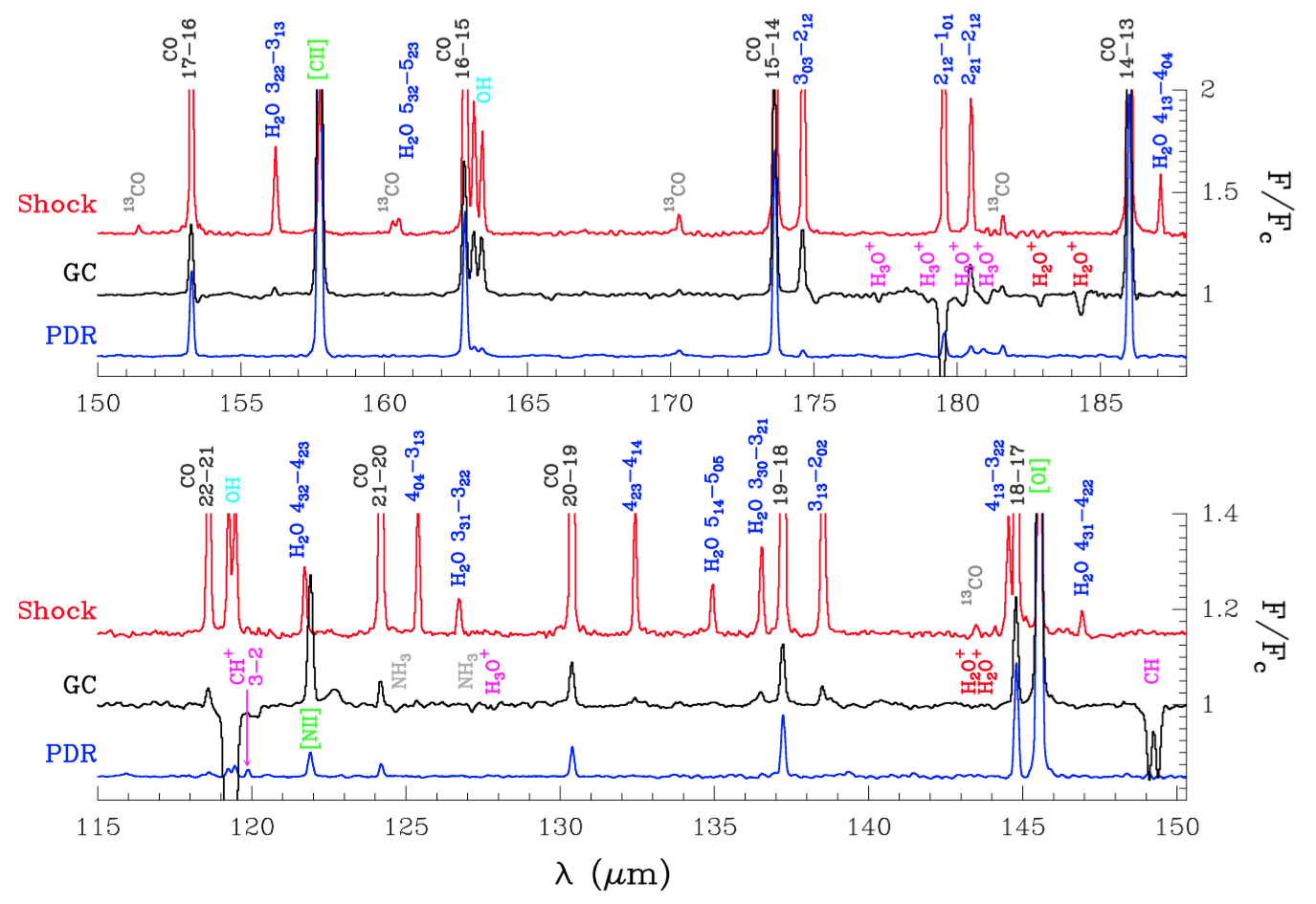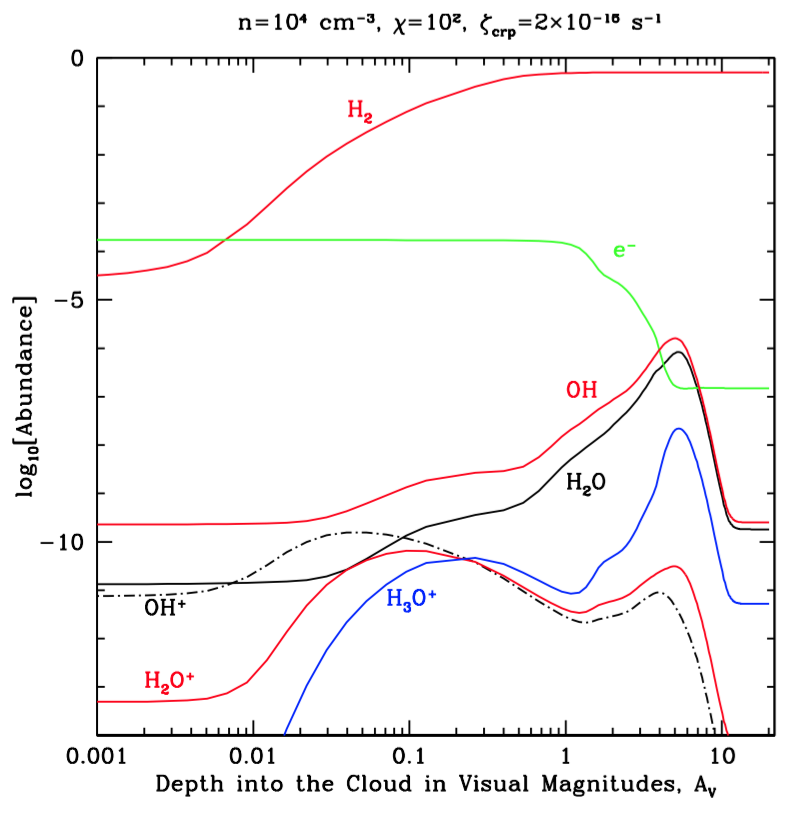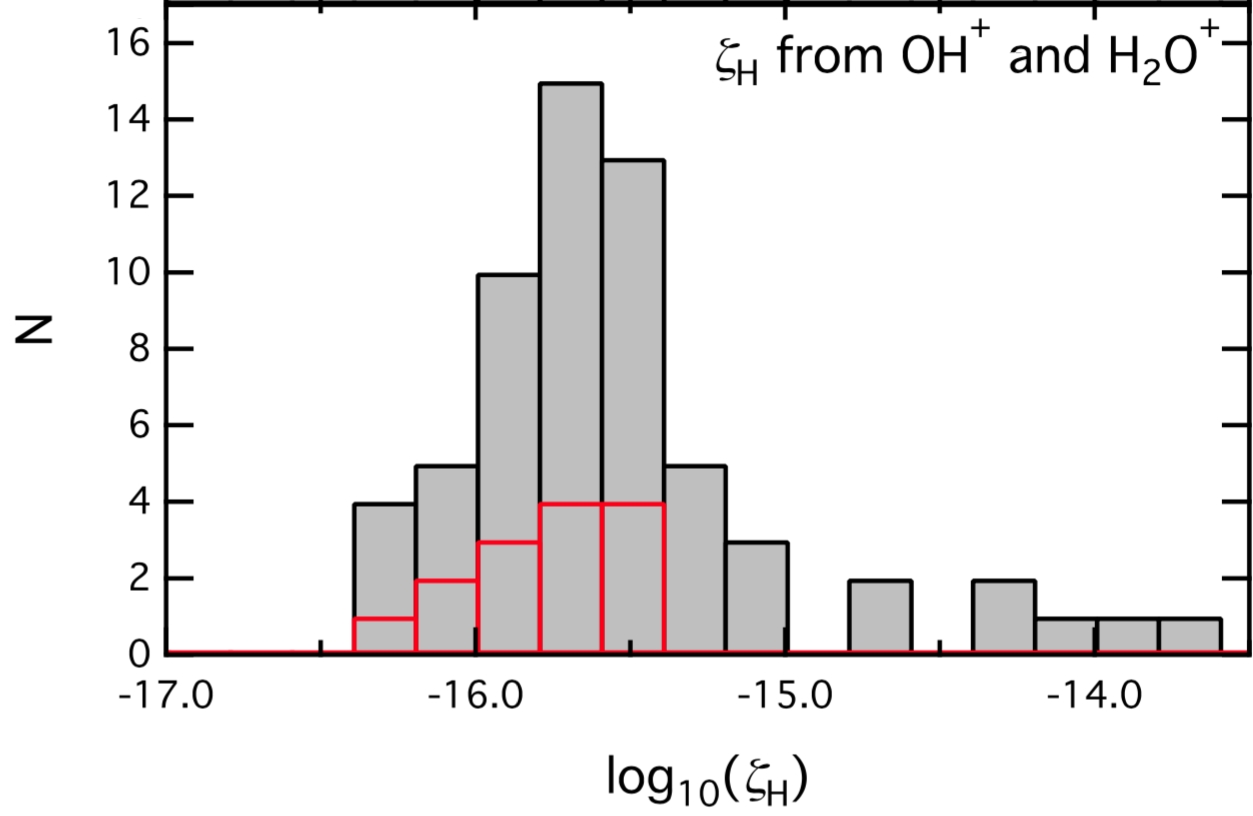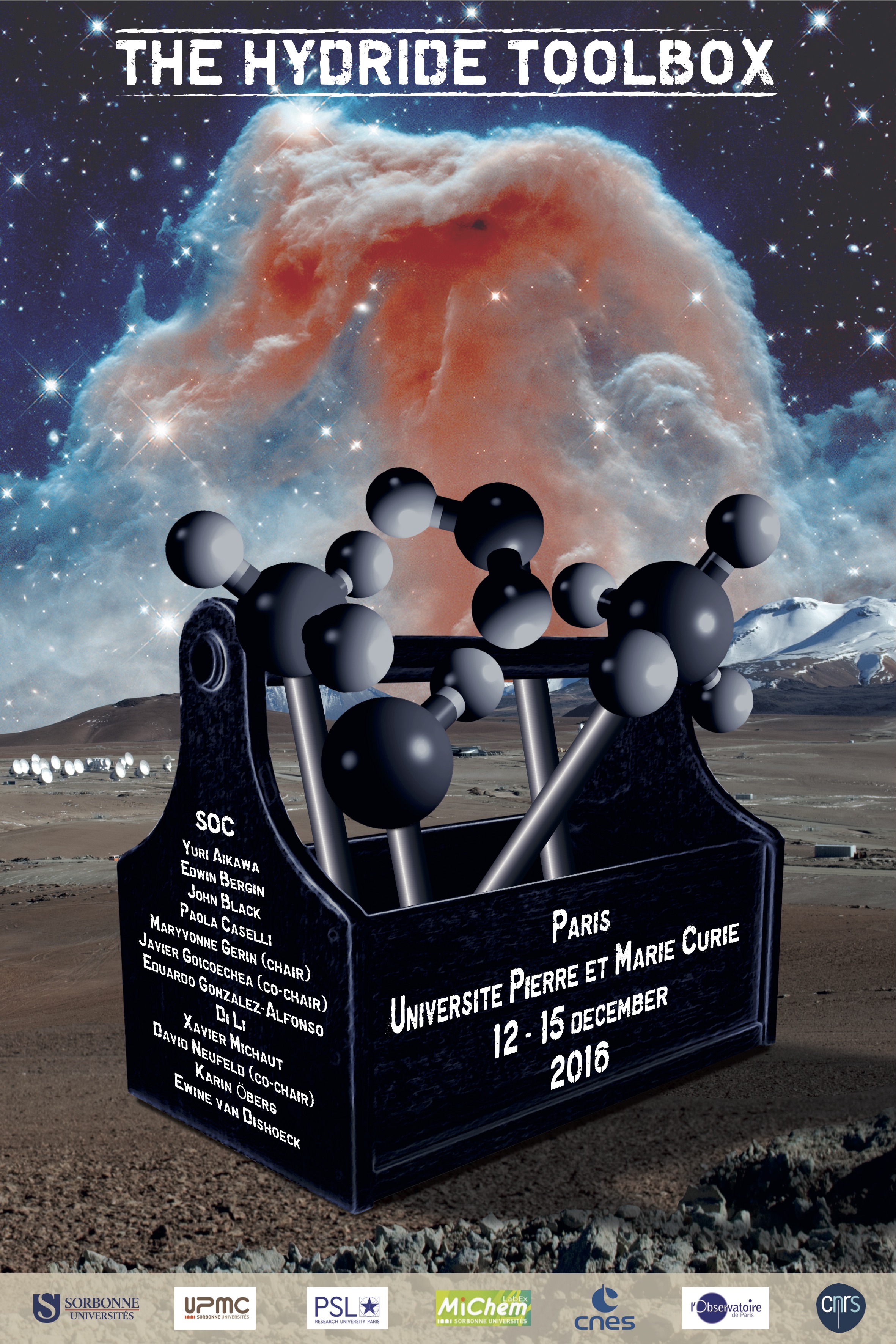Conference rationale
 Hydrides are defined as molecules, radicals, and molecular ions containing one heavy atom (e.g., C, N, O, F, S, Cl, Ar, etc.) bound with one or several hydrogen atoms. Very abundant in the interstellar medium, these species were among the first molecules detected in space. With the recent development of submillimeter astronomy - in particular the Herschel satellite and the SOFIA stratospheric airplane - they are now observed in a wide range of environments, including low density diffuse matter, dense FUV illuminated interfaces of molecular gas and HII regions, cold and dense prestellar cores, molecular shocks, and even distant objects at high redshift.
Hydrides are defined as molecules, radicals, and molecular ions containing one heavy atom (e.g., C, N, O, F, S, Cl, Ar, etc.) bound with one or several hydrogen atoms. Very abundant in the interstellar medium, these species were among the first molecules detected in space. With the recent development of submillimeter astronomy - in particular the Herschel satellite and the SOFIA stratospheric airplane - they are now observed in a wide range of environments, including low density diffuse matter, dense FUV illuminated interfaces of molecular gas and HII regions, cold and dense prestellar cores, molecular shocks, and even distant objects at high redshift.
 Efficiently formed through hydrogenation of atomic gas, hydrides lie at the root of interstellar chemistry and of the formation of complex organic species. Despite the apparent simplicity of their chemistry, the development of models capable of explaining the observations of hydrides has required several decades. Many independent factors contributed to enhance the difficulty: the relative scarcity of astronomical data due to the limitation of observing from the ground ; the specific thermodynamic properties of a few hydrides of astronomical interest which raised issues regarding their formation timescales ; and the need for advanced modeling approaches combining fluid dynamics, gas phase and solid phase chemistries, and excitation processes including radiative and chemical formation pumping.
Efficiently formed through hydrogenation of atomic gas, hydrides lie at the root of interstellar chemistry and of the formation of complex organic species. Despite the apparent simplicity of their chemistry, the development of models capable of explaining the observations of hydrides has required several decades. Many independent factors contributed to enhance the difficulty: the relative scarcity of astronomical data due to the limitation of observing from the ground ; the specific thermodynamic properties of a few hydrides of astronomical interest which raised issues regarding their formation timescales ; and the need for advanced modeling approaches combining fluid dynamics, gas phase and solid phase chemistries, and excitation processes including radiative and chemical formation pumping.
 The improvements of state-of-the-art modelling combined with the recent progresses in theory and in laboratory data have led to a better understanding of astronomical hydrides, and have opened the possibility to use them as powerful diagnostics of the interstellar medium, both in our Galaxy or at cosmological distances. Indeed hydrides have now been used in various ways to determine several important properties of the ISM such as, the density, the temperature, the molecular hydrogen content, the cosmic ray ionization rate, the turbulent dissipation rate, the magnetic field intensity, the ice condensation and evaporation processes, and the evolutionary time scale of matter. In parallel, they have become important probes of planet formation processes, tracing the role of the snow line in the growth of planet embryos, and the emergence of planet atmospheres.
The improvements of state-of-the-art modelling combined with the recent progresses in theory and in laboratory data have led to a better understanding of astronomical hydrides, and have opened the possibility to use them as powerful diagnostics of the interstellar medium, both in our Galaxy or at cosmological distances. Indeed hydrides have now been used in various ways to determine several important properties of the ISM such as, the density, the temperature, the molecular hydrogen content, the cosmic ray ionization rate, the turbulent dissipation rate, the magnetic field intensity, the ice condensation and evaporation processes, and the evolutionary time scale of matter. In parallel, they have become important probes of planet formation processes, tracing the role of the snow line in the growth of planet embryos, and the emergence of planet atmospheres.
Figures are taken from Goicoechea et al. (2013, 2015), Joblin et al. (in prep.), Hollenbach et al. (2012) and Indriolo et al. (2015). They are reproduced with permission from AAS managed by IOP publishing ©AAS
Main topics
- Molecular physics and chemistry of hydrides
- Diffuse ISM, turbulence, and shocks
- Cosmic rays and magnetic field
- Extragalactic and AGN activity
- Solid phase processes and chemistry
- Stars and planet formation, exoplanets
- ISM life cycle
- Future projects
Conference poster


 Hydrides are defined as molecules, radicals, and molecular ions containing one heavy atom (e.g., C, N, O, F, S, Cl, Ar, etc.) bound with one or several hydrogen atoms. Very abundant in the interstellar medium, these species were among the first molecules detected in space. With the recent development of submillimeter astronomy - in particular the Herschel satellite and the SOFIA stratospheric airplane - they are now observed in a wide range of environments, including low density diffuse matter, dense FUV illuminated interfaces of molecular gas and HII regions, cold and dense prestellar cores, molecular shocks, and even distant objects at high redshift.
Hydrides are defined as molecules, radicals, and molecular ions containing one heavy atom (e.g., C, N, O, F, S, Cl, Ar, etc.) bound with one or several hydrogen atoms. Very abundant in the interstellar medium, these species were among the first molecules detected in space. With the recent development of submillimeter astronomy - in particular the Herschel satellite and the SOFIA stratospheric airplane - they are now observed in a wide range of environments, including low density diffuse matter, dense FUV illuminated interfaces of molecular gas and HII regions, cold and dense prestellar cores, molecular shocks, and even distant objects at high redshift. Efficiently formed through hydrogenation of atomic gas, hydrides lie at the root of interstellar chemistry and of the formation of complex organic species. Despite the apparent simplicity of their chemistry, the development of models capable of explaining the observations of hydrides has required several decades. Many independent factors contributed to enhance the difficulty: the relative scarcity of astronomical data due to the limitation of observing from the ground ; the specific thermodynamic properties of a few hydrides of astronomical interest which raised issues regarding their formation timescales ; and the need for advanced modeling approaches combining fluid dynamics, gas phase and solid phase chemistries, and excitation processes including radiative and chemical formation pumping.
Efficiently formed through hydrogenation of atomic gas, hydrides lie at the root of interstellar chemistry and of the formation of complex organic species. Despite the apparent simplicity of their chemistry, the development of models capable of explaining the observations of hydrides has required several decades. Many independent factors contributed to enhance the difficulty: the relative scarcity of astronomical data due to the limitation of observing from the ground ; the specific thermodynamic properties of a few hydrides of astronomical interest which raised issues regarding their formation timescales ; and the need for advanced modeling approaches combining fluid dynamics, gas phase and solid phase chemistries, and excitation processes including radiative and chemical formation pumping. The improvements of state-of-the-art modelling combined with the recent progresses in theory and in laboratory data have led to a better understanding of astronomical hydrides, and have opened the possibility to use them as powerful diagnostics of the interstellar medium, both in our Galaxy or at cosmological distances. Indeed hydrides have now been used in various ways to determine several important properties of the ISM such as, the density, the temperature, the molecular hydrogen content, the cosmic ray ionization rate, the turbulent dissipation rate, the magnetic field intensity, the ice condensation and evaporation processes, and the evolutionary time scale of matter. In parallel, they have become important probes of planet formation processes, tracing the role of the snow line in the growth of planet embryos, and the emergence of planet atmospheres.
The improvements of state-of-the-art modelling combined with the recent progresses in theory and in laboratory data have led to a better understanding of astronomical hydrides, and have opened the possibility to use them as powerful diagnostics of the interstellar medium, both in our Galaxy or at cosmological distances. Indeed hydrides have now been used in various ways to determine several important properties of the ISM such as, the density, the temperature, the molecular hydrogen content, the cosmic ray ionization rate, the turbulent dissipation rate, the magnetic field intensity, the ice condensation and evaporation processes, and the evolutionary time scale of matter. In parallel, they have become important probes of planet formation processes, tracing the role of the snow line in the growth of planet embryos, and the emergence of planet atmospheres.

